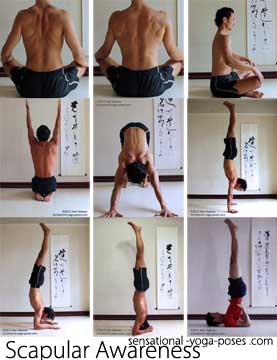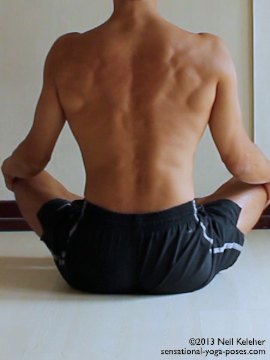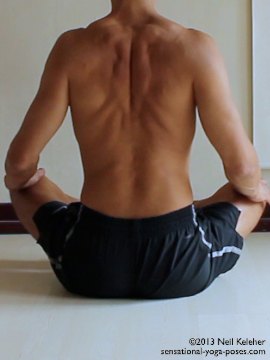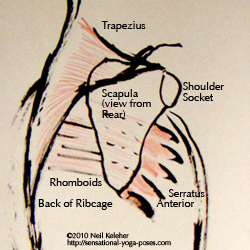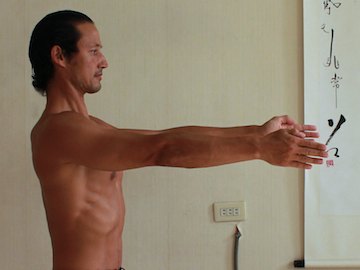Basic Shoulder Blade Movements
To maximize scapular mobility and awareness, the following scapular movements can be practiced:
- Moving the shoulder blades away from the spine (scapular protraction)
- Moving them towards the spine (scapular retraction)
- Elevation with Rotation
- Elevation without Rotation
- Pec Minor Activation (flipping the shoulder blade over the ribcage)
- Depression with Rotation (Lower fibers of trapezius).
Stabilize the Ribcage (and Align It)
One of the primary actions that you can practice before trying to control the scapulae is to expand and stabilize the ribcage. This then gives the muscles that control the scapulae a firm foundation from which to work.
A good exercise for expanding the ribcage is costal breathing.
If you have shoulder imbalances, i.e. one shoulder weaker or less flexible than the other, check the side to side alignment of your ribcage with respect to your pelvis and also the side to side alignment of your head with respect to your ribcage.
Practice Without Weight First to Develop Awareness
In the exercises below you can practice all of these shoulder movements with the arms not bearing weight so that it is easier to develop scapular awareness and then create shoulder stability.
The idea is to learn how to activate the muscles that control the scapulae so that they you can use the same muscles to resist movements of the shoulder blades relative to the ribcage and thus create shoulder stability.
In positions where the arms are lifted shoulder stability can be created by using these same muscles to resist the weight of the arms.
Shoulder Blade Landmarks
Major scapular landmarks used in the exercises below include the accromion process, the scapular ridge and the inner edge of each shoulder blade.
The idea isn't just to know where these landmarks are but to actually focus on them while you practice moving your shoulder blades.
- The inner edges of the shoulder blade are a particularly handy landmark since the rhomboids, the serratus anterior and levator scapulae all attach there.
- The scapular ridge and accromion process are handy landmarks for isolating the trapezius muscle.
Scapular Stability and Protraction
When spreading the scapulae (protraction), they slide around the sides of the ribcage towards the front of the body. This action uses the serratus anterior muscle which connects to the inner edges of the shoulder blades. It reaches around the sides of the ribcage to attach to ribs 1 through 9.
For this scapular protraction exercise first lengthen the neck and lift the front ribs so that the serratus anterior has a stable foundation (the ribs) from which to act.
This action is helpful when stabilizing the scapulae with arms in front of the body.
Start with your shoulders relaxed. Then move your shoulders forwards. Then relax them so that they return to neutral.
As you move your shoulders forwards, feel the inner edges of the shoulder blades moving outwards, away from each other (bottom left). As your shoulders move back feel the inner edges moving towards each other. (bottom right).
Once you can feel the inner borders of your shoulder blades, see if you can notice any tension at the back of your shoulder blades, between your scapulae and upper arm bone. This would indicate that you are activating the muscles that connect your scapula to your upper arm, more than likely the infraspinatus and teres minor.
See if you can relax these muscles and keep them relaxed while moving your shoulder blades back and forwards.
Scapular Awareness: Retracting Your Shoulder Blades
Next focus on moving your shoulders back from neutral so that your shoulder blades move towards each other.
Again focus on moving slowly and smoothly and also focus on feeling the inner edges of your shoulder blades.
This time focus on drawing the inner edges of the shoulder blades towards each other during the active phase of this exercise.
This action is handy when stabilizing the scapulae with the arms behind the body.
The Rhomboids and Serratus Anterior Muscles.
The muscles that act to pull your shoulder blades inwards are the rhomboids and like the serratus anterior muscle the rhomboids also attach to the inner edges of the shoulder blades.
The serratus anterior act to pull the shoulder blades outwards, away from each other.
Scapular Awareness With the Arms in Front of Your Body
Once you are used to the above shoulder awareness exercises, you can do the same movements but with your arms reaching forwards.
Work at slowly spreading your shoulder blades (below left) and then retract them (below right).
I often see students having trouble with spreading (and then retracting) their shoulder blades while in cat pose. This exercise helps them to develop the necessary scapular awareness relatively easily.
Scapular Awareness with the Arms to the Sides
With the arms out to the sides as in the yoga pose warrior 2 some teachers suggest retracting the shoulder blades. My own preference is to spread them so that the arms feel maximally long.
So that you can experience both options and choose for yourself you can practice spreading the shoulder blades and retracting them with arms out to the sides. The serratus anterior will be active when spreading the shoulder blades while the rhomboids will be active when pulling them together.
So for both actions you can focus your awareness on the inner border of the shoulder blades.
Note that this arm position is also used in side plank with the bottom arm supporting the weight of the body. In side plank it is easy to bend the spine to the side to give the posture more lift. And so another option is to practice spreading the shoulder blades and retracting them with the lumbar and thoracic spine bent to the side.
The Pectoralis Minor and Scapular Awareness
The pectoralis minor or "pec minor" attaches the top of the shoulder blade just above and in front of the shoulder socket. It's anchored to the ribs. When active it can be used to pull the front of the shoulders downwards and inwards. This can be a "protective" or "shy" gesture and it may actually be easier to do if you engage your abs and bend your spine forwards at the same time.
First focus on rolling the front of your shoulder inwards and downwards. Then relax.
Once you are comfortable with this action see if you can isolate your shoulder blade. Rather than pulling down and in on the upper arm and shoulder blade focus on moving just the shoulder blade. The arm will follow but the idea here is to not activate the pectoralis major (the large chest muscle.)
The advantage of this exercise is that you not only learn to deliberately activate pectoralis minor, you can also learn how to relax it.
The Lower Fibers of the Trapezius
A muscle that may, in some cases, counter the pec minor and in some cases work with it is the lower fibers of the Trapezius muscle. These fibers attach to the spine of the scapulae about a third inwards from the inner border. These fibers can be used to pull the inner edge of the scapula down the back.
With shoulders relaxed and chest lifted focus on pulling the inner edge of the scapulae down the back. Then relax. For extra fine tuning of your scapulae awareness focus on a point on each scapular ridge, about an inch inwards from the inner edge of each scapulae.
This action can be useful for stabilizing the shoulders when lifting the hips off of the floor while seated.
Exercise Quality
When doing any of the above shoulder stabilization exercises focus on the following qualities:
Use a Slow and Smooth Rhythm
For this and any other exercise where you are learning to feel your body, or a part of it, use slow, smooth and repeated rhythmic movements.
Moving slowly and smoothly forces you to focus on what you are moving (in this case the shoulder blades).
Repeating the movement gives you the chance to learn to feel and recognize the movement so that, for example, you learn to recognize when your shoulder blades are spread (protracted) and when they aren't.
Start with a General Movement, Then Focus Your Awareness
The instructions start of with a basic movement, for example, moving your shoulders forwards, and then relaxing so that they return to the starting position.
Once you can do this basic movement without any trouble, then you can narrow your focus. So that you use your serratus anterior when moving your shoulders forwards, focus on feeling (and moving) the inner borders of the scapulae. (If you can already move your shoulders forwards and backwards without any problems then you can skip straight ahead to pulling the inner borders of your shoulder blades away from your spine.
Memorize the Feeling
Once you have the action (i.e. spreading the shoulder blades) memorize the feeling so that you can carry that feeling (and the action) into poses or actions where the arms are bearing weight so that you can keep your target muscle active and your scapula stable.
Shoulder Basics for Shoulder Flexibility
The ebook Yoga for Your Shoulders includes the above exercises and more for improved scapular awareness and shoulder flexibility and shoulder stability.
Published: 2014 11 29
